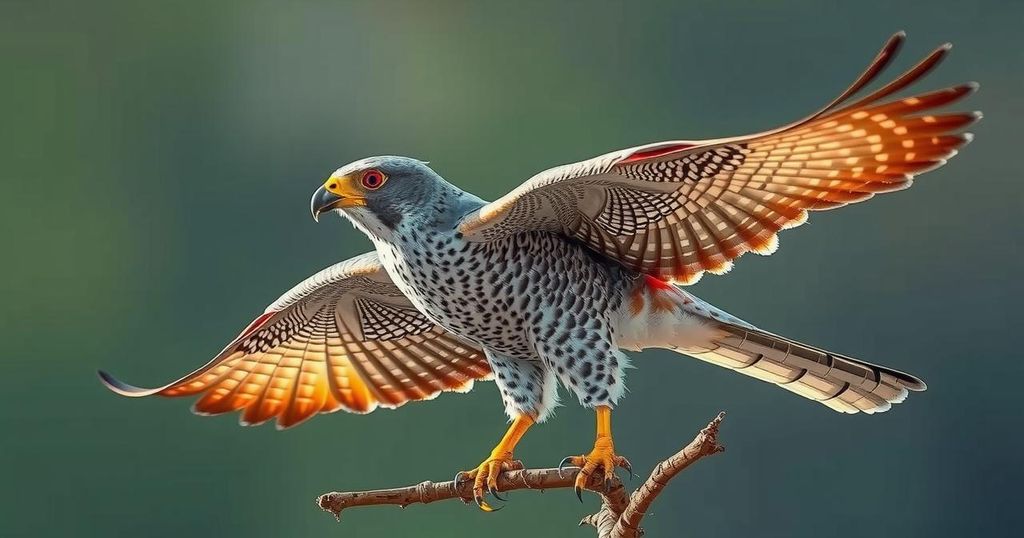Satellite-Tagged Amur Falcon Makes Remarkable Migration to Somalia-Kenya Border

Chiuluan 2, a satellite-tagged Amur falcon from Manipur, has reached the Somalia-Kenya border after crossing the Arabian Sea. This journey is being tracked by Senior Scientist R. Suresh Kumar of the Wildlife Institute of India. The satellite tagging initiative aims to study migration patterns while another falcon, Guangram, remains in the release area. Amur falcons are considered the world’s longest-traveling birds, migrating approximately 20,000 km yearly.
In a remarkable demonstration of migratory endurance, Chiuluan 2, a satellite-tagged Amur falcon released from Tamenglong district in Manipur, has successfully traversed to the Somalia-Kenya border via a stopover in Somalia. This male falcon initiated its journey from Guhagar in Maharashtra, Maharashtra’s Ratnagiri district, on Sunday at approximately 10:30 AM and reached Somalia by Tuesday evening. As of Friday, Chiuluan 2 was situated near the Somalia-Kenya border. The project, overseen by Senior Scientist R. Suresh Kumar from the Wildlife Institute of India (WII), aims to monitor the migratory routes of these birds.
Another falcon, a female named Guangram, remains at the release site in Tamenglong. Both falcons were tagged with satellite transmitters on November 8, as part of a collaborative initiative involving the Manipur Forest Department, WII, and local villagers, designed to study their migratory behavior and the environmental variables impacting their route. On the same day, a total of nine other Amur falcons were ringed and released.
Notably, Amur falcons, referred to locally as ‘Akhuaipuina,’ are recognized as the longest-traveling avian species globally, migrating roughly 20,000 kilometers annually. Protectively classified under the Wildlife Protection Act of 1972, they typically breed in Southeast Russia and Northeast China before moving to their wintering sites in South Africa. Their migration includes important stopovers in Northeastern India, especially in states like Manipur and Nagaland.
The tagging efforts for Amur falcons commenced in Tamenglong in 2018, continuing with additional birds tagged in the subsequent year. These conservation initiatives are critical for gauging the migratory patterns and challenges that these remarkable birds face. The accomplishments of the Manipur Forest Department and local communities signify a dedicated commitment to securing the protection of these raptors and their ecosystems, with Chiuluan 2’s successful migration exemplifying the importance of such conservation projects.
The Amur falcon, identified as the world’s longest-migrating bird species, embarks on an annual journey from breeding grounds in Southeast Russia and Northeast China to winter in South Africa. This extensive migration, spanning approximately 20,000 kilometers, involves critical stopovers in various locations, including Northeast India and Somalia. The study of these migratory patterns helps in understanding the environmental challenges faced by these birds. Conservation efforts, such as satellite tagging, provide insights into their behavior and habitat needs, enhancing protection strategies for their populations.
The journey of Chiuluan 2 serves not only as a testament to the resilience of Amur falcons but also highlights the importance of collaborative conservation efforts. The satellite-tagging initiative is pivotal in understanding the migratory routes of these raptors, thereby contributing to their protection. The combined efforts of the Manipur Forest Department and local communities continue to play a significant role in the ongoing conservation of these remarkable birds, ensuring they thrive in their natural habitats. Their annual migration is not only a natural wonder but also a vital ecological phenomenon that underscores the need for environmental conservation.
Original Source: www.eastmojo.com






